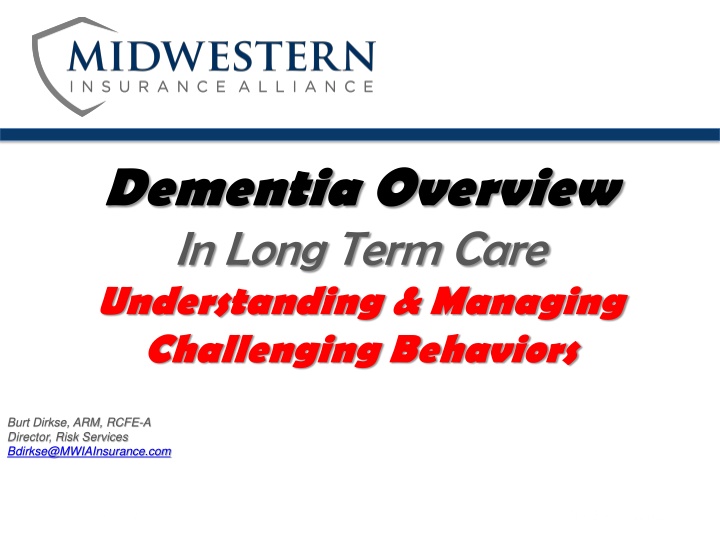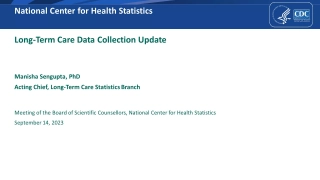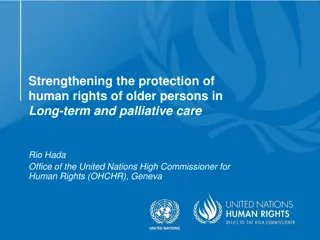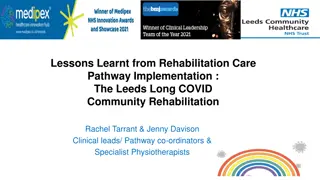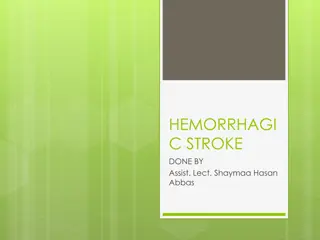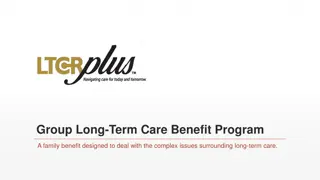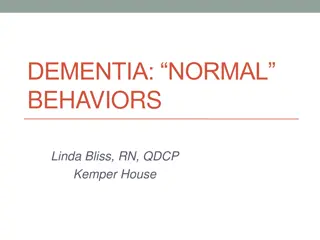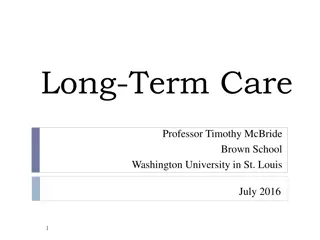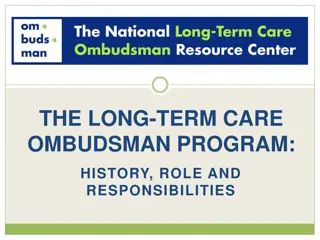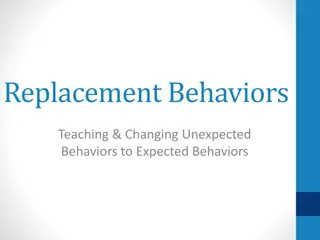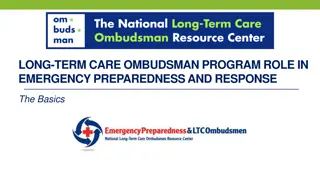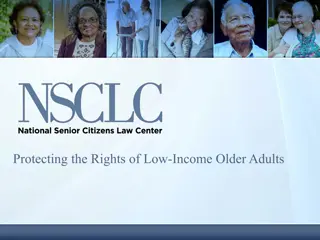Managing Challenging Behaviors in Long-Term Care
Resident aggression in long-term care facilities can cause physical and psychological trauma to both staff and residents. Understanding the signs of pain and discomfort in residents with dementia is crucial for providing effective care. Observing facial expressions, body movements, and visualizations can help identify potential pain. Recognizing signs such as pressure sores, bruising, and refusal to eat is important in addressing residents' needs promptly. Reporting any observed symptoms to supervisors or nurses is essential for proper management and potentially addressing serious health conditions beyond pain. Emotional pain, such as sadness and loneliness, can also impact residents' well-being.
Download Presentation

Please find below an Image/Link to download the presentation.
The content on the website is provided AS IS for your information and personal use only. It may not be sold, licensed, or shared on other websites without obtaining consent from the author.If you encounter any issues during the download, it is possible that the publisher has removed the file from their server.
You are allowed to download the files provided on this website for personal or commercial use, subject to the condition that they are used lawfully. All files are the property of their respective owners.
The content on the website is provided AS IS for your information and personal use only. It may not be sold, licensed, or shared on other websites without obtaining consent from the author.
E N D
Presentation Transcript
Dementia Overview In Long Term Care Understanding & Managing Challenging Behaviors Burt Dirkse, ARM, RCFE-A Director, Risk Services Bdirkse@MWIAInsurance.com
Resident aggression causes physical and psychological trauma to both staff and other residents. 88,000 of the 1.3 million nursing home residents (6.8%) are physically aggressive each week.* Residents may have underlying psychiatric conditions, cognitive impairment and dementia, which contribute to combativeness. More than 5 million residents have Alz disease (2014) and other dementias, which will escalate rapidly as the baby boomer generation ages *Potentially Modifiable Resident Characteristics That Are Associated With Physical or Verbal Aggression Among Nursing Home Residents With Dementia, 2006
We all have aches and pains, especially as we age. Our residents are no exception. Res with dementia may be unable to identify their pain or seek an effective remedy. Our role as caregivers is to be observant of the unspoken signs of pain and be proactive in providing treatment and relief.
Facial expressions Frown, grimace, tension, muscle tightening, frightened appearance, eyes closed tightly, eyes wide open, rapid blinking Body movements, body language Changes in mobility or walking gait, guarding of self or part of body, rubbing a particular part of body, wringing hands, clenching fists, restlessness Visualizations Shouting, screaming, crying, noisy breathing, asking for help repeatedly, becoming verbally abusive Watch for physical signs of pain during caregiving- bathing, toileting, dressing and dining.
Signs to look for.. Pressure sores Redness/swelling Arthritis/deformities in a joint Refusal to eat or loss of appetite Bruising Noisy breathing Skin tears Sweating Unusual paleness 1 2 3 4
What to do If you observe any of these symptoms, report them to your supervisor or nurse immediately They may be indicative of pain, but also symptoms of a more serious health condition, such as UTI, heart problems, pneumonia
Emotional Pain Sadness, fear, loneliness are examples, and can make residents more aware of their physical pain. Non-medical interventions can decrease resident s pain Engaging residents to overcome emotional pain can include: Offering food, beverage or toileting Walking, music, baking or fun conversation Spending time outdoors together on a sunny day Reassuring them and listening as they describe their concerns. Listening to soothing music or offering a gentle hand massage Repositioning to a more comfortable position or location, esp if in a wheelchair
More emotional pain interventions Reminiscing about residents lives or talking about a favorite subject from their Life Story. Exercising Holding hands or giving a hug Serving them their favorite snack Playing with a visiting pet.
Treatment of dementia While there is no cure for dementia, these conditions are considered treatable. Socialization is the best treatment for dementia Provide support to residents to maximize their abilities
Memory medications Meds can slow the dementia process for some, but the effects are short- lived. Many residents take memory-enhancing meds such as Aricept, Exelon, Razadyne or Namenda While these don t stop the underlying disease progression, they may have a positive impact on behavior as decreasing frustration, anxiety and agitation. Common side-effects of these meds: Drowsiness, dizziness, constipation or diarrhea, increased confusion, nausea or vomiting, tremors, rapid heartbeat, muscle rigidity, blurred vision, sweating, dry mouth Reactions to meds will vary by resident, and meds may have the opposite effect of what was intended, may worsen the dementia by over-sedating. If you notice these side-effects, report the condition immediately
Socialization as treatment Many times, hugs are better than drugs. Create a warm, caring envt with lots of engagement, meaningful programming/activities and socialization Learn residents Life Stories and use them in your approach, communication and activities Become a great listener and don t correct them. This requires good acting skills. If their stories change, go with it. Support them with wherever they are in the moment. It s not about being right.
Watch for treatable issues Dementia can be worsened by: Not wearing glasses or wearing the wrong glasses Excessive noise and confusion Missing hearing aids or battery failure Sudden health issues such as UTI Poor lighting in a room Glare from window or shadows Pain physical or emotional Over-stimulation or fatigue
Manage the Situation Prevention & De-escalation Maintain your composure (be aware of your emotions, tone, body language) Approach resident calmly and express support, use positive/friendly facial expressions. Always approach resident from the front, not the back. Active Listening: engage resident to determine needs, if possible Effective verbal responding: reflect/paraphrase to clarify understanding. Use gentle, relaxed tone. Redirection: provide options of other activities or places. Stance: talk with them at eye level. Arms at sides, not crossed. Maintain appropriate distance if potential for hitting exists. Do NOT initiate physical contact if the resident s behavior is escalating. Touching can trigger violence in some. Positioning: is res comfortable ? Repositioned regularly as needed ? Jumping to conclusions: input from other team members is helpful, however, fully assess the resident/situation/environment. Never assume. Resident stress management: exercise, walking, calming music, pet therapy, favorite doll or blanket.
Managing Challenging Behaviors Behaviors are part of the disease process and are expected. They re normal for the residents condition. We must handle them creatively and compassionately The resident is often trying to tell us something; it s up to us to figure out what that is. Learn how to turn a No into a Yes.
Behaviors Behaviors can be a form of communication. As residents lose cognitive skills and vocabulary, their actions and emotions may be the only way they can express their wants and needs. Someone who is sad and crying may be telling you they are frightened and need a hug and reassurance Someone who is pacing may be telling you he needs to go to the bathroom Someone who is tapping their foot or showing anxiousness may need something to eat or drink Someone who wants to leave may be telling you that she needs more activity and engagement
Be a good detective When a challenging behavior develops, you must figure out what need is not being met and then meet it.
Causes & triggers of behavior Resident s physical or emotional state pain, dehydration, UTI. They could be sad or depressed. These can contribute to challenging behaviors Problems in the environment Noise, stimulation, clutter can cause stress for residents. Keep mood positive and happy (even if you re not feeling it). Act. Fake it if you have to. Remain calm
Causes & triggers of behavior Tasks that are too demanding Expecting too much or giving a resident an overly difficult task can cause push-back and result in challenging behaviors Communication difficulties Challenging behaviors can happen when residents can t understand or process what we re asking them to do, or when they re unable to understand what they need. They ll probably not tell you that they don t understand; they ll just exhibit frustration
Managing Challenging Behaviors Remember To offer residents food, drink and toileting. Sometimes, they don t realize they need to use the bathroom or that they re hungry or thirsty Reassure Assure them that they are safe, secure and loved. Redirect Distract the resident by assisting them to focus on something else. Change the subject. Move to a different location. Change of face.
Managing Challenging Behaviors Reconsider Is the behavior actually a problem or is it just annoying to you ? Reapproach If the resident doesn t want to cooperate in a task or activity, leave them for a moment and come back to try again later. Repeat State your question or request a second time if they don t respond immediately.
Managing Challenging Behaviors Rephrase State your comment or request in simple terms; break instructions in small steps. Reassess Ask yourself if the behavior is abnormal Reaffirm Validate the emotions that are being expressed. Don t ignore what they are feeling. Get into their reality and ask questions. Tell then that you can see they are upset or sad and try giving them a big smile or hug.
Questions ? Discussion of specific challenges Problem residents How to respond
